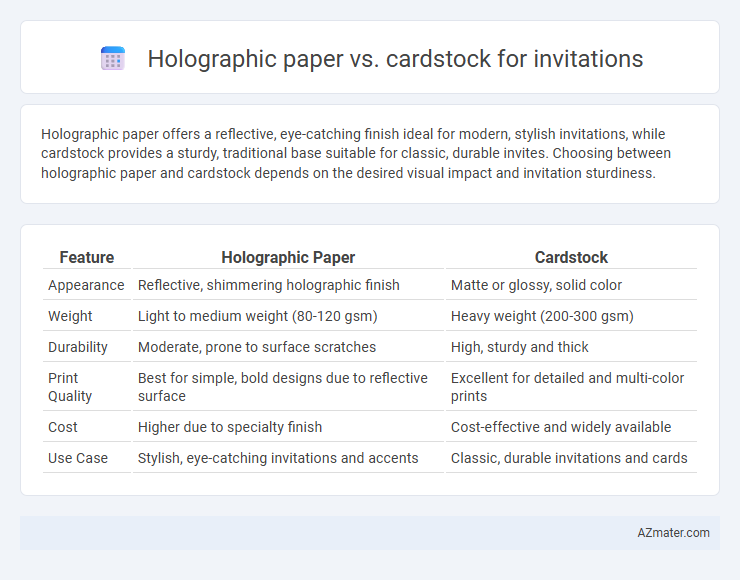Holographic paper offers a reflective, eye-catching finish ideal for modern, stylish invitations, while cardstock provides a sturdy, traditional base suitable for classic, durable invites. Choosing between holographic paper and cardstock depends on the desired visual impact and invitation sturdiness.
Table of Comparison
| Feature | Holographic Paper | Cardstock |
|---|---|---|
| Appearance | Reflective, shimmering holographic finish | Matte or glossy, solid color |
| Weight | Light to medium weight (80-120 gsm) | Heavy weight (200-300 gsm) |
| Durability | Moderate, prone to surface scratches | High, sturdy and thick |
| Print Quality | Best for simple, bold designs due to reflective surface | Excellent for detailed and multi-color prints |
| Cost | Higher due to specialty finish | Cost-effective and widely available |
| Use Case | Stylish, eye-catching invitations and accents | Classic, durable invitations and cards |
Introduction to Invitation Materials
Holographic paper offers a striking, reflective surface that enhances the visual appeal of invitations by creating a dynamic, eye-catching effect. Cardstock provides a sturdy, textured base that delivers durability and a premium feel, ideal for formal or traditional invitations. Selecting between holographic paper and cardstock depends on the desired aesthetic impact and the tactile quality needed for the event's tone.
What is Holographic Paper?
Holographic paper is a specialty material featuring a reflective, multi-dimensional surface that creates a rainbow-like effect when exposed to light, making invitations visually striking and unique. Unlike cardstock, which is thicker and offers a matte or glossy finish, holographic paper prioritizes vibrant aesthetics and eye-catching appeal but may require mounting on sturdier backing for durability. This paper is ideal for invitations aiming to impress through dynamic visual texture and sophisticated shimmer, enhancing event themes with a modern and luxurious touch.
What is Cardstock?
Cardstock is a thick, durable paper known for its sturdiness and smooth surface, making it ideal for crafting high-quality invitations that require a professional appearance. Unlike holographic paper, which features a shiny, reflective finish to create a visually striking effect, cardstock provides a solid base suitable for printing detailed text and designs with crisp clarity. Its weight and rigidity ensure invitations remain flat and presentable, enhancing the overall tactile experience for recipients.
Visual Impact: Holographic Paper vs Cardstock
Holographic paper creates a striking visual impact with its reflective, multidimensional surface that captures and refracts light, making invitations appear dynamic and eye-catching. Cardstock offers a more traditional, matte or glossy finish that emphasizes texture and rigidity but lacks the vibrant, shifting color effects found in holographic materials. For invitations aiming to impress with bold, luminous aesthetics, holographic paper delivers unparalleled visual appeal compared to the understated elegance of cardstock.
Texture and Feel Comparison
Holographic paper offers a smooth, glossy texture with a reflective surface that creates a vibrant, eye-catching appearance, ideal for modern, flashy invitations. Cardstock features a thicker, sturdier feel with a matte or slightly textured surface that conveys a classic, elegant touch and ensures durability. The choice between holographic paper and cardstock depends on whether the invitation aims for a sleek, contemporary look or a traditional, tactile experience.
Durability and Strength
Holographic paper offers a striking visual appeal but generally lacks the durability and strength compared to cardstock, making it more prone to creasing or tearing. Cardstock, typically thicker and sturdier, provides superior resilience, ensuring invitations remain intact during handling and shipping. For long-lasting invitations, cardstock is preferred due to its robustness and ability to withstand wear and tear.
Print Compatibility and Techniques
Holographic paper offers unique light-reflective properties that require specialized inkjet or laser printers compatible with thin, glossy media to prevent smudging and ensure vibrant holographic effects. Cardstock, characterized by its thicker and sturdier composition, supports a wide range of printing techniques including digital, offset, and screen printing, delivering sharper images and text with enhanced durability. Choosing between holographic paper and cardstock depends on print compatibility with your equipment and the desired visual impact for your invitations.
Cost Analysis: Holographic vs Cardstock
Holographic paper typically costs 2-3 times more than standard cardstock due to its specialized manufacturing and reflective finish, making it a premium choice for invitations seeking a unique visual impact. Cardstock offers a more affordable option with a wide range of thicknesses and finishes, providing versatility for budget-conscious projects while maintaining durability and print quality. For large event invitations, cardstock can significantly reduce overall costs, whereas holographic paper suits smaller runs or premium events where standout aesthetics justify the higher expense.
Eco-Friendliness and Sustainability
Holographic paper often contains metallic and plastic elements that make it difficult to recycle, negatively impacting its eco-friendliness compared to traditional cardstock. Cardstock is typically made from biodegradable, recycled materials, offering a more sustainable option for invitations. Choosing recycled or FSC-certified cardstock further enhances environmental responsibility by reducing waste and conserving natural resources.
Choosing the Best Material for Your Invitations
Holographic paper offers a visually striking, reflective surface that elevates invitation designs with vibrant color shifts, making it ideal for high-impact, modern events. Cardstock provides a sturdy, traditional feel with excellent durability and a wide range of finishes, ensuring a timeless and professional appearance. Selecting the best material depends on the event's style and budget, with holographic paper suited for bold, creative invitations and cardstock favored for classic, formal affairs.

Infographic: Holographic paper vs Cardstock for Invitation
 azmater.com
azmater.com